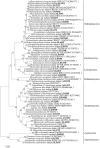Chemically-Mediated Interactions Between Macroalgae, Their Fungal Endophytes, and Protistan Pathogens
- PMID: 30627120
- PMCID: PMC6309705
- DOI: 10.3389/fmicb.2018.03161
Chemically-Mediated Interactions Between Macroalgae, Their Fungal Endophytes, and Protistan Pathogens
Abstract
Filamentous fungi asymptomatically colonize the inner tissues of macroalgae, yet their ecological roles remain largely underexplored. Here, we tested if metabolites produced by fungal endophytes might protect their host against a phylogenetically broad spectrum of protistan pathogens. Accordingly, the cultivable fungal endophytes of four brown algal species were isolated and identified based on LSU and SSU sequencing. The fungal metabolomes were tested for their ability to reduce the infection by protistan pathogens in the algal model Ectocarpus siliculosus. The most active metabolomes effective against the oomycetes Eurychasma dicksonii and Anisolpidium ectocarpii, and the phytomixid Maullinia ectocarpii were further characterized chemically. Several pyrenocines isolated from Phaeosphaeria sp. AN596H efficiently inhibited the infection by all abovementioned pathogens. Strikingly, these compounds also inhibited the infection of nori (Pyropia yezoensis) against its two most devastating oomycete pathogens, Olpidiopsis pyropiae, and Pythium porphyrae. We thus demonstrate that fungal endophytes associated with brown algae produce bioactive metabolites which might confer protection against pathogen infection. These results highlight the potential of metabolites to finely-tune the outcome of molecular interactions between algae, their endophytes, and protistan pathogens. This also provide proof-of-concept toward the applicability of such metabolites in marine aquaculture to control otherwise untreatable diseases.
Keywords: fungal endophytes; macroalgae; metabolome; molecular interactions; protistan pathogens; pyrenocines; secondary metabolites.
Figures






References
-
- Abdel-Wahab M. A., Pang K. L., Nagahama T., Abdel-Aziz F. A., Jones E. B. G. (2010). Phylogenetic evaluation of anamorphic species of Cirrenalia and Cumulospora with the description of eight new genera and four new species. Mycol. Prog. 9, 537–558. 10.1007/s11557-010-0661-x - DOI
LinkOut - more resources
Full Text Sources

